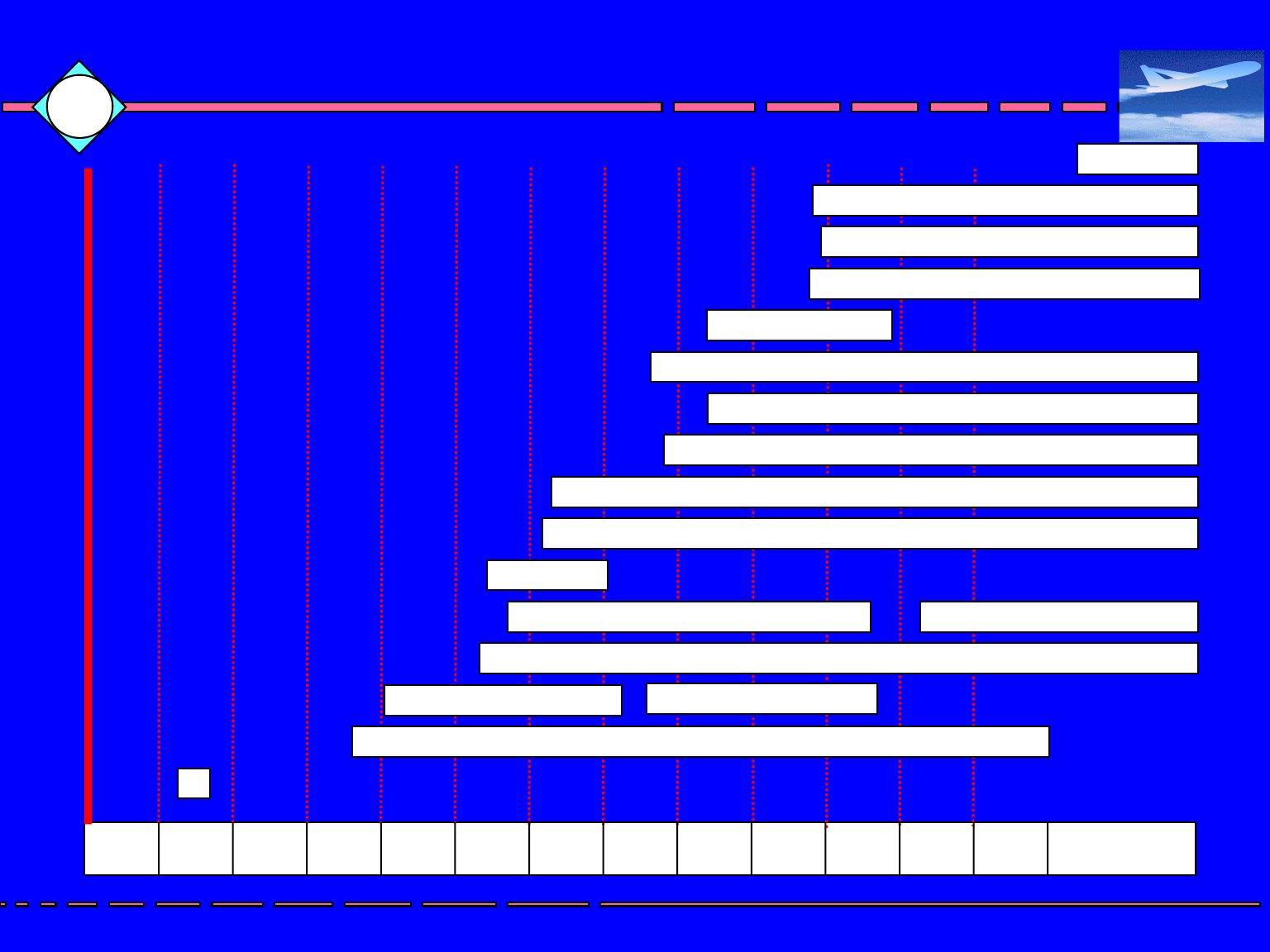
making nets work
CNS
1
Aviation Wireless Communications
Chris Wargo
Presented to
IAB Workshop on
Wireless Internetworking
February 29 - March 2, 2000
Computer Networks & Software, Inc.

making nets work
CNS
2
Agenda
! Today's Aeronautical Telecommunication Network
(ATN)
! Potential of TCP/IP Architecture for Aviation
! Mobility Management Requirements
! Summary
! Discussion

making nets work
CNS
3
Wireless Application Categories (Voice and Data)
! Air Traffic Management (ATM)
– Air Traffic Control (ATC)
– Air Traffic Services (ATS)
– Communication, Navigation, & Surveillance (CNS)
! Airline Operational Communications (AOC)
– Flight Operations
– Maintenance
– Airport/Ramp Operations
! Airline Administrative Communications (AAC)
! Airline Passenger Communications (APC)
! Entertainment

making nets work
CNS
4
Global Customers of the Wireless Aviation
Market
Type
Size Indication
Commercial Aviation
15,000 Aircraft plus
( times # of passengers)
Business Aviation
25,000 Aircraft plus
General Aviation
100,000 Aircraft plus
Cargo Aviation
10,000 Aircraft plus
Military
50,000 Aircraft plus
Government 184 Countries of ICAO

making nets work
CNS
5
Aeronautical Telecommunication (ATN) Network
Environment
ATN ROUTER
ATN ROUTERATN ROUTER
Avionics Subnetwork
Mode S Subnetwork HF SubnetworkSatellite SubnetworkVHF Subnetwork
CAA Ground
Subnetwork
Management
Processor
ATN End System
Aeronautical
Operations
Data Base
ATN End System
Data Display
Processor
ATN End System
Data Entry
Processor
ATN End System
Management
Processor
ATN End System
Aeronautical
Operations
Control
ATN End System
Weather
Data Base
ATN End System
ATC
ATN End System
FIS
Data Base
ATN End System
Weather
Data Base
ATN End System
Service Provider
Ground Subnetwork
Airline Ground
Subnetwork

making nets work
CNS
6
Evolution of Aviation Wireless Communications
1960 1965 1970 1975 1980 1985 1990 1995 2000 2005 2010 2015 2020
PanAm Satcom Demo
FANS Committee
VDL Mode 2
CPDLC I&IA
PETAL II & LINK 2000
ATN - ISO Definition
GPS
SATCOM (ATS,AOC,APC)
CPDLC II & III
NEXCOM VDL Mode 3
VDL Mode 4
CNS/ATM - FANS 1&A
2025+
ACARS
EACARS & AVPAC Attempts
Passenger Telephone Systems
HF Data Link
ATN - IPv? Definition
SATS

making nets work
CNS
7
Consists of Applications and communication services that allow
ground, air-ground, and avionics sub-networks to inter-operate
End System(ES)
Application
Entity
Upper Layer
Communications
Service
Internet
Communications
Service
Intermediate
System (IS)
Application
Entity
Upper Layer
Communications
Service
Internet
Communications
Service
Intermediate
System (IS)
Subnetwork Subnetwork Subnetwork
End System(ES)
ATN Architecture
Context Management (CM) Application
Automatic Dependent Surveillance (ADS)
Controller Pilot Data Link Communication (CPDLC)
Flight Information Service (FIS)
ATS Message Handling Services (ATSMHS)

making nets work
CNS
8
Aeronautical Communication Requirements
! Interoperability with existing subnetworks
! High availability
! Mobile Communication
! Message prioritization
! Policy based routing
! Security
! Bit Efficiency
! Support for multiple mobile subnetworks
! Mobile platform forms its own Routing domain

making nets work
CNS
9
Today’s ATN Status
! ICAO - 91 Nations Agreement 1991
! Published Standards - SARPS Edition 3, end of 2000
! Several Cooperative Attempts - Stalled Out
! FAA Funded Router Development - ATNS,Inc.
! Limited ATN Router Availability
! End System Applications under development
! Wireless Components not yet “Red Label”
! European, Eurocontrol lead early trials ongoing
! FAA CPDLC I - Initial Operation 2002

making nets work
CNS
10
Application
Connection Oriented
Session Protocol (COSP)
Transport Layer (TP4)
Network Layer (CLNP)
Air-Ground
Subnetwork
Ground-Ground
Subnetwork
Application Service Element
(ASE)
Dialog Service (DS)
Control
Function
(CF)
Application
Layer
Application
Transport Layer (TP4)
Network Layer (CLNP)
Air-Ground
Subnetwork
Ground-Ground
Subnetwork
ASE
DS
ACSE
CF
Fast Byte COPP
and COSP
ATN Protocol Architecture
Connection Oriented
Presentation Protocol (COPP)
Sub
Networks
Association Control Service
Element (ACSE)
ISO
Air-Ground
Fast Byte approach selected to obtain bit efficiency over the Air-Ground Link

making nets work
CNS
11
Transport Layer (TCP)
Network Layer (IP)
Air-Ground
Subnetwork
Ground-Ground
Subnetwork
ATN and TCP/IP Protocol Architecture
Transport Layer (TP4)
Network Layer (CLNP)
Air-Ground
Subnetwork
Ground-Ground
Subnetwork
Application
ASE
DS
ACSE
CF
Fast Byte COPP
and COSP
Application
ATN Architecture
TCP/IP Architecture
With the Fast Byte enhancements, the two architectures appear similar in structure

making nets work
CNS
12
TCP and TP4 Features Comparison
Both support Connection-oriented and Connectionless
Transport services
Function TCP Protocol TP4 Protocol
Data transfer Streams Blocks
Flow control Octets Segments
Error detection Checksum Checksum
Error correction Retransmission Retransmission
Addressing 16 bit ports Variable TSAP address
Interrupt service Urgent data Expedited data
Security Supported Variable in TP
Precedence Supported 16 bits in TP
Connection termination Graceful Non graceful
Source: Aeronautical Related Applications Using ATN and TCP/IP Research Report, prepared by CNS for the NASA Glenn Research Center, November 23, 1999

making nets work
CNS
13
IP and CLNP Features Comparison
Function CLNP IP
Versi on ID 1 octet 4 bits
Header length 1 octet, represented in octets 4 bits, represented in 32 bit words
Quality of service QoS maintenance option Type of Service (Class)
Segment/fragment
length
16 bits, in octets 16 bits, in octets
Total l e ngt h 16 bits, in octets 16 bits, in octets
Data unit ID 16 bits 16 bits
Flags Don’t segment, more segments Don’t fragment, more fragments
Segment/fragment offset 16 bits, represented in octets 13 bits, represented in units of 8
octets
Lifetime, time to live 1 octet, represented in 500 millisecond
units
1 octet, represented in 1-second units
Higher layer protocol Not present Protocol identifier
Lifetime control 500 millisecond units 1-second units
Addressing Var i abl e leng t h 32-bit fixed (128 bits)
Both support Connectionless Network services
Source: Aeronautical Related Applications Using ATN and TCP/IP Research Report, prepared by CNS for the NASA Glenn Research Center, November 23, 1999

making nets work
CNS
14
IP and CLNP Features Comparison
Function CLNP IP
•
Security
•
Security
•
Priority
•
Precedence bits in TOS
(Class)
•
Complete source
routing
•
Strict source route
•
Partial source
routing
•
Loose source route
•
Record route
•
Record route
•
Padding
•
Padding
•
Not present
•
Timestamp
Options
•
Reason for discard
(Error PDU only)
•
Uses ICMP messages
Source: Aeronautical Related Applications Using ATN and TCP/IP Research Report, prepared by CNS for the NASA Glenn Research Center, November 23, 1999

making nets work
CNS
15
Challenge for the Aeronautical World
Could TCP/IP protocol meet Aeronautical requirements?
! Benefits:
– Lower Infrastructure cost
– Potential for new services:
» VoIP
» Multicast
» Security
» Integration with Public Infrastructure
Challenges:
! Modifying Political agreement/ Industry Standards
! Addressing Technical Issues for:
– Mobility Management
– Policy based routing capability

making nets work
CNS
16
Subnetworks
Air-Ground (A/G):
! Aeronautical Mobile Satellite
! VHF Data Link
! Mode S
! HF Data link
! Passenger Telephony
Ground-Ground:
! X.25 PSDNs
! Frame Relay
! LANs
! Leased Lines
! NADIN

making nets work
CNS
17
Overview of VDL Modes
Mode
Data Vo i ce
VDL Mode 1 Ye s
No
VDL Mode 2
Ye s No
VDL Mode 3
Ye s
Ye s
VDL Mode 4 Ye s
No
Characteristics
• Provide 4 logically independent channels in a 25kHz frequency
assignment.
• Each channel can be allocated to voice or data. Uses differentially
encoded 8-phase shift keying (D8PSK) at 31.5 kbps
• Standard media access control based on 4 slots structure
• Extended range uses 3 slot structure
• Uses Self-organizing Time division multiplexing (STDMA)
• Uses TDMA based short time slots
• Uses a reservation protocol to gain link access
• Data rate of 1200 bps
• Channel shared among all using aircraft
• Channel access based Carrier Sense Multiple Access (CSMA)
• Uses the same frequency band as Mode1, but uses better data
encoding modem
• Differentially encoded 8-phase shift keying (D8PSK) with channel
data rate of 31.5 kbps
• Channel access based Carrier Sense Multiple Access (CSMA)

making nets work
CNS
18
Subnetworks Requirements
! Byte and code independence
! Address individual systems
! Provide error detection
– Undetected error better than 1 in 10
8
! Packet mode technology
! Connectionless and Connection mode
! Prioritization of data
– Important for safety related data
! QoS Management
– Throughput and Transit delay guarantees
! Mobile subnetworks
– Ability to report aircraft joining the subnetwork
– Ability identify aircraft leaving a subnetwork

making nets work
CNS
19
Mobility and Roaming
! Mobility between subnetworks while staying in contact
– Supported by the data link layer
! ATN must support Roaming between networks
– Aircraft may move from one mobile subnetwork to
another
– Aircraft may be simultaneously attached to more than
one mobile subnetwork

making nets work
CNS
20
Mobile Routing Issues
! Routes cannot be aggregated
– Mobile addresses not related to topology
! Route changes every time aircraft changes point of
attachment
– High rate of routing updates
! Routers have to keep a route for each aircraft
– ATN size limited by router table capacity

making nets work
CNS
21
ATN Solutions for Mobility
! Uses Inter Domain Routing Protocol (IDRP) for routing
! Implements distributed IDRP directory using Boundary
Intermediate Systems (BISs)
! Two level directory
– ATN Island concept consisting of backbone BISs
– Home BISs concept
! Scalability obtained by the two level structure
! Resilience is provided by the distributed approach

making nets work
CNS
22
ATN Island Routing Domain Confederation
ATN TRD ATN TRD
ATN Backbone RDC
ATN TRD
ATN ERD
ATN ERD
ATN Island RDC
Mobile RD
Mobile RD
Mobile RD
Another
ATN Island

making nets work
CNS
23
Mobile Routing Example
RD1 RD2
RD3
RD4
! RD1, RD2 and RD3 support air/ground data links and
RD4 depends on the other three (3) for A/G
communication.
! Using IDRP RD1 and RD2 advertise a route to the aircraft
and RD4 can choose one of the route based on Routing
policy.

making nets work
CNS
24
Mobile Routing Example
! As the aircraft travels it may lose contact RD1, RD1
informs others using the route withdraw message.
! RD4 now has one path to the aircraft through RD2 and
thus routes all traffic through RD2.
! Further along in the flight, the aircraft may come in
contact with RD3. A data link is established and routing
information is exchanged. RD3 then advertises a new
route to the aircraft.
! RD4 again has two routes to the aircraft and chooses a
route based on local routing policy. The aircraft goes
through a similar process to select a route.

making nets work
CNS
25
ATN Mobile Protocol Requirements
! Shall support wide variety of mobile communications networks including aeronautical mobile-
satellite service (AMSS), VHF digital link (VDL), HF digital link and SSR Mode S. Shall be
possible to communicate wit h airborne avionics in any part of the world.
! Shall support wide range of Organizational and National polices, including the enforcing of
restrictions on what types of traffic can pass over both ground and air/ground data links, and
control over which air/ground data link types are used by which applications
! BISs shall advertise routes to each other, where a route consists of the set of addresses which
identifies the destinations reachable over the router, and information about the route's path
including the Quality of Service and Security available over the route.
! Shall support policy based routing that enables users to control external access to their
communications resources, and to protect themselves from problems elsewhere in the
internetwork.
! The ATN, mobile “platforms” on board an aircraft shall form a Routing Domain and must
include an ATN Router that is also a BIS.
! Shall support a two level concept of default route providers (ATN Island and Home) for
containing high rate of information flow, and also to avoid the problems of routing instability
caused by a rapid turnover of routing information.
! Mobile routing shall support the user requirement that the users can specify, on a per
application basis, routing control requirements.

making nets work
CNS
26
NASA System Testbed Configuration

making nets work
CNS
27
Summary
! Aviation’s use of TCP/IP could yield significant
benefits.
! Without a common solution for mobile routing,
Aviation’s ISO oriented ATN will remain in place.
! Adopting IDRP-like mechanisms for mobile IP versus
a BGP-like approach is a step in Aviation’s direction.

making nets work
CNS
28
Wireless Application Categories (Voice and Data)
! Air Traffic Management (ATM)
– Air Traffic Control (ATC)
– Air Traffic Services (ATS)
– Communication, Navigation, & Surveillance (CNS)
! Airline Operational Communications (AOC)
– Flight Operations
– Maintenance
– Airport/Ramp Operations
! Airline Administrative Communications (AAC)
! Airline Passenger Communications (APC)
! Entertainment
Mobile IP
?

making nets work
CNS
29
Acronym List
ATN Aeronautical Telecommunication Network
ACARS Aircraft Communications Addressing and Reporting System
ACSE Association Control Service Element
AMSS Aeronautical Mobile-Satellite Service
ASE Application Service Element
BIS Boundary Intermediate System
CF Control Function
COPP Connection Oriented Presentation Protocol
COSP Connection Oriented Session Protocol
CPDLC Controller-Pilot Data Link Communications
DS Dialogue Service
ERD End Routing Domain
ICAO International Civil Aviation Organization
FANS Future Air Navigation System
IDRP Inter Domain Routing Protocol
NADIN North American Digital Information Network (FAA)
PETAL Preliminary European Test of Air/Ground Data Link
RD Routing Domain
RDC Routing Domain Confederation
TRD Transit Routing Domain
VDL VHF Digital Link

making nets work
CNS
30
Industry Initiatives
! ATN
– Context Management (CM) Application
– Automatic Dependent Surveillance (ADS )
– Contr oller Pilot Data Link Comm unication (CPD L C )
– Flight Inform a tio n Service (FIS)
– ATS Message Handling Services (ATSM HS)

making nets work
CNS
31
Air Traffic Management (ATM)
! Predeparture Clearance
! Taxi Cleara nce
! Context Management
! Controller to Pilot Data Link Communication
! Automatic Dependent Surveillance
! Waypoint Position Reporting
! Emergency Messages
! Future Air Navigation System
! Oceanic Clearance
! Future Free Flight
! Flight Information Services
! Airport Terminal Information Service
! Digital Airport Terminal Information Service
! Flight Information Services Broadcast
! Notice to Airmen
! METAR
! Ter minal Weathe r Informati on to Pi l ots
! Local Area Augmentation System
! Wide Area Augmentation System
! Cockpit Voice (ATC)

making nets work
CNS
32
AOC, AAC, APC and Entertainment
Data Link Related System Control, Peripherals,
and Subsystems (6 Applications/61 Formats)
Flight Operations (14 Applications/30 Formats)
Maintenance Operations (6 Applications)
Airport/Ramp Area Operations
Cockpit Voice Operations (Company)
Airline Administrative Communications (AAC)
Airline Operational Communications (AOC)
Airlines Gate Connections
Medical Assistance Requests
Crew Schedule and Lodging Information
Miscellaneous Freetext Crew Information
Future Applications – Passenger Handling
Tel e phony
E-Mail
Internet Services
Facsimile
Airline Passenger Communications (APC)
Entertainment
Games
Movies/Videos
Gambling
Shopping
Automated Teller Machines
